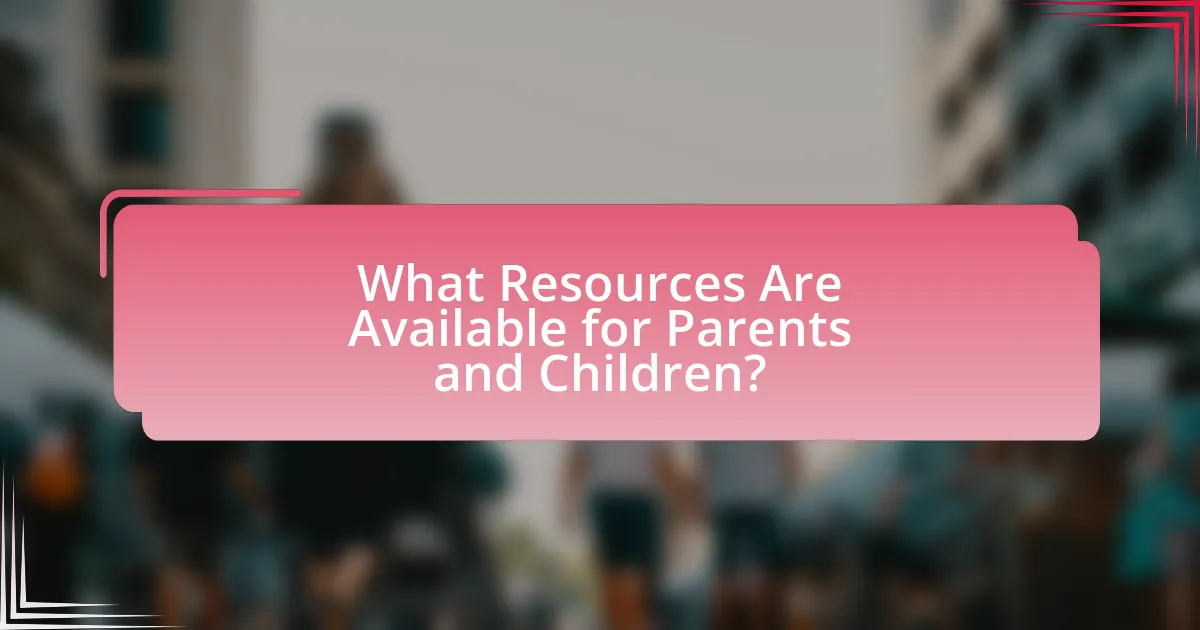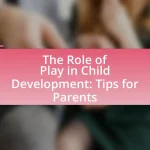The article “Supporting Children Through Grief: A Guide for Parents” provides a comprehensive overview of how grief affects children and the importance of parental support during this challenging time. It outlines the emotional, behavioral, and cognitive signs of grief in children, emphasizing the need for parents to recognize these indicators to provide appropriate support. The article discusses strategies for fostering open communication, establishing routines, and encouraging creative expression to help children cope with their feelings. Additionally, it highlights the significance of professional resources, such as counseling and support groups, in aiding children’s emotional well-being and resilience during the grieving process.

What is Grief and How Does it Affect Children?
Grief is a profound emotional response to loss, particularly the loss of a loved one, and it significantly affects children by altering their emotional, behavioral, and cognitive functioning. Children may experience grief differently than adults, often expressing it through play, art, or changes in behavior rather than through verbal communication. Research indicates that children can exhibit symptoms such as sadness, anger, confusion, and anxiety, which can impact their social interactions and academic performance. A study published in the Journal of Child Psychology and Psychiatry found that children who experience the death of a parent are at a higher risk for developing mental health issues, underscoring the importance of providing support during this critical time.
What are the common signs of grief in children?
Common signs of grief in children include sadness, anger, anxiety, changes in behavior, and withdrawal from social interactions. Children may express their grief through crying, irritability, or regression to earlier developmental stages, such as bedwetting or thumb-sucking. Research indicates that children might also experience physical symptoms like stomachaches or headaches as manifestations of their emotional distress. These signs can vary based on the child’s age and personality, but recognizing them is crucial for providing appropriate support during the grieving process.
How can parents identify emotional changes in grieving children?
Parents can identify emotional changes in grieving children by observing shifts in behavior, mood, and communication. Common indicators include increased irritability, withdrawal from social interactions, changes in sleep patterns, and alterations in appetite. Research indicates that children may express grief through play or art, reflecting their emotional state. Additionally, parents should pay attention to verbal expressions of sadness or confusion, as children may struggle to articulate their feelings. Recognizing these signs can help parents provide appropriate support and interventions during the grieving process.
What physical symptoms might indicate a child is grieving?
Physical symptoms that might indicate a child is grieving include changes in appetite, sleep disturbances, fatigue, and somatic complaints such as headaches or stomachaches. Research shows that children often express emotional distress through physical manifestations, as they may lack the vocabulary to articulate their feelings. For instance, a study published in the Journal of Child Psychology and Psychiatry found that children experiencing grief frequently report physical ailments alongside emotional symptoms, highlighting the interconnectedness of physical and emotional health during the grieving process.
Why is it important to support children through grief?
Supporting children through grief is crucial because it helps them process their emotions and understand loss in a healthy way. When children receive support, they are more likely to develop coping mechanisms that can prevent long-term psychological issues, such as anxiety or depression. Research indicates that children who are supported during grief are better equipped to express their feelings and navigate their grief journey, leading to improved emotional resilience. For instance, a study published in the Journal of Child Psychology and Psychiatry found that children who received appropriate grief support showed significantly lower levels of distress compared to those who did not.
How can unresolved grief impact a child’s development?
Unresolved grief can significantly hinder a child’s emotional, social, and cognitive development. When children experience loss and do not process their grief, they may exhibit symptoms such as anxiety, depression, and behavioral issues, which can interfere with their ability to form healthy relationships and succeed academically. Research indicates that children who do not receive adequate support during grief are at a higher risk for long-term mental health problems, including post-traumatic stress disorder (PTSD) and chronic emotional distress. For instance, a study published in the Journal of Child Psychology and Psychiatry found that unresolved grief can lead to difficulties in emotional regulation and increased vulnerability to peer rejection, ultimately affecting a child’s overall development and well-being.
What are the long-term effects of grief on children?
The long-term effects of grief on children can include emotional, behavioral, and cognitive challenges. Children who experience significant loss may develop anxiety, depression, or post-traumatic stress disorder, which can persist into adulthood. Research indicates that children may struggle with social relationships and academic performance due to unresolved grief. For instance, a study published in the Journal of Child Psychology and Psychiatry found that children who experienced the death of a parent were at a higher risk for mental health issues later in life, emphasizing the importance of addressing grief early on.

How Can Parents Support Their Grieving Children?
Parents can support their grieving children by providing a safe space for them to express their feelings. Open communication is essential; parents should encourage their children to talk about their emotions and memories related to the loss. Research indicates that children who feel supported in expressing their grief are more likely to cope effectively (Worden, J.W. “Grief Counseling and Grief Therapy”). Additionally, parents should validate their children’s feelings, reassuring them that it is normal to feel sad, angry, or confused after a loss. Engaging in shared activities, such as creating memory projects or participating in rituals, can also help children process their grief. By being present and attentive, parents can foster resilience and emotional healing in their grieving children.
What strategies can parents use to help children cope with grief?
Parents can help children cope with grief by encouraging open communication about feelings and providing a safe space for expression. This approach allows children to articulate their emotions, which is crucial for processing grief. Research indicates that children who can discuss their feelings are better equipped to manage their grief (Worden, J.W. “Grief Counseling and Grief Therapy”). Additionally, parents can establish routines to create a sense of stability, which can be comforting during times of loss. Engaging in memorial activities, such as creating memory boxes or participating in rituals, can also help children honor their loved ones while facilitating healing.
How can open communication facilitate healing in grieving children?
Open communication facilitates healing in grieving children by allowing them to express their feelings and thoughts about their loss. When children can openly discuss their emotions, they are more likely to process their grief effectively, reducing feelings of isolation and confusion. Research indicates that children who engage in conversations about their grief experience less anxiety and demonstrate healthier coping mechanisms. For instance, a study published in the Journal of Child Psychology and Psychiatry found that children who communicated openly about their grief showed improved emotional adjustment over time. This highlights the importance of fostering an environment where children feel safe to share their experiences, ultimately aiding in their healing journey.
What role does routine play in supporting a grieving child?
Routine plays a crucial role in supporting a grieving child by providing stability and predictability during a time of emotional upheaval. Establishing a consistent daily schedule helps the child feel secure, as it creates a sense of normalcy amidst the chaos of loss. Research indicates that children thrive on routine, which can mitigate anxiety and foster a sense of control. For instance, a study published in the Journal of Child Psychology and Psychiatry found that structured environments can significantly improve emotional regulation in children facing grief. By maintaining regular activities such as meals, school, and playtime, caregivers can help grieving children navigate their feelings and gradually adjust to their new reality.
How can parents encourage expression of feelings in children?
Parents can encourage the expression of feelings in children by creating a safe and open environment for communication. This involves actively listening to children without judgment, validating their emotions, and using age-appropriate language to discuss feelings. Research indicates that children who feel safe to express their emotions are more likely to develop emotional intelligence and resilience. For instance, a study published in the Journal of Child Psychology and Psychiatry found that children who engage in open discussions about their feelings are better equipped to cope with grief and loss.
What activities can help children express their grief creatively?
Art activities such as drawing, painting, and crafting can help children express their grief creatively. Engaging in these activities allows children to visualize their emotions and communicate feelings that may be difficult to articulate verbally. Research indicates that creative expression can facilitate emotional processing and healing in children, as it provides a safe outlet for their grief. For instance, a study published in the Journal of Child Psychology and Psychiatry found that art therapy significantly improved emotional expression and coping skills in grieving children. Additionally, writing stories or letters to lost loved ones can also serve as a therapeutic way for children to process their feelings and memories.
How can parents model healthy grieving behaviors?
Parents can model healthy grieving behaviors by openly expressing their emotions and discussing their feelings about loss. This approach teaches children that it is normal to grieve and that sharing emotions can be a healthy part of the grieving process. Research indicates that children who observe their parents navigating grief in a healthy manner are more likely to develop their own effective coping strategies (Worden, J.W. “Grief Counseling and Grief Therapy”). Additionally, parents can demonstrate healthy grieving by maintaining routines, seeking support from friends or professionals, and allowing themselves to experience joy alongside their sorrow, which reinforces the idea that grief and happiness can coexist.

What Resources Are Available for Parents and Children?
Resources available for parents and children include counseling services, support groups, educational materials, and online platforms focused on grief support. Counseling services provide professional guidance to help families navigate their emotions, while support groups offer a community for sharing experiences and coping strategies. Educational materials, such as books and articles on grief, equip parents with knowledge to assist their children effectively. Online platforms, including websites and forums, facilitate access to resources and connect families with others facing similar challenges. These resources are essential for fostering understanding and healing during the grieving process.
What types of professional support can assist grieving children?
Professional support for grieving children includes counseling, support groups, and therapy specifically designed for children. Counseling provides a safe space for children to express their feelings and learn coping strategies, while support groups allow them to connect with peers experiencing similar losses, fostering a sense of community. Additionally, therapy, such as play therapy or art therapy, can help children process their grief through creative expression. Research indicates that these forms of support can significantly improve emotional well-being and resilience in grieving children, as evidenced by studies showing that children who participate in grief counseling report lower levels of anxiety and depression.
How can therapy or counseling benefit a grieving child?
Therapy or counseling can significantly benefit a grieving child by providing a safe space for them to express their emotions and process their grief. This professional support helps children understand their feelings, normalize their experiences, and develop coping strategies. Research indicates that children who engage in therapy during grief are more likely to exhibit improved emotional regulation and resilience. For instance, a study published in the Journal of Child Psychology and Psychiatry found that therapeutic interventions can lead to a reduction in symptoms of depression and anxiety in grieving children, highlighting the effectiveness of counseling in promoting emotional well-being during such a challenging time.
What should parents look for in a grief support group?
Parents should look for a grief support group that offers a safe and empathetic environment for sharing experiences. This includes trained facilitators who understand child grief, structured activities that engage both parents and children, and a focus on emotional expression. Research indicates that support groups with these characteristics can significantly improve coping mechanisms and emotional well-being for grieving families. For instance, a study published in the Journal of Child Psychology and Psychiatry found that children who participated in structured grief support showed reduced symptoms of depression and anxiety.
What books or materials can help children understand grief?
Books and materials that can help children understand grief include “The Invisible String” by Patrice Karst, which illustrates the concept of connection despite loss, and “When Dinosaurs Die: A Guide to Understanding Death” by Laurie Krasny Brown and Marc Brown, which provides straightforward explanations about death. Additionally, “I Miss You: A First Look at Death” by Pat Thomas offers age-appropriate insights into feelings of loss. These resources are effective because they use relatable narratives and illustrations to convey complex emotions, making it easier for children to process their grief.
Which age-appropriate resources are recommended for children?
Age-appropriate resources recommended for children include picture books, interactive apps, and support groups tailored to their developmental stage. For instance, picture books like “The Invisible String” by Patrice Karst help children understand and cope with loss through relatable narratives. Interactive apps such as “My Grief” provide engaging activities that allow children to express their feelings. Additionally, support groups specifically designed for children, like those offered by organizations such as The Dougy Center, provide a safe space for children to share their experiences and emotions with peers facing similar challenges. These resources are effective in helping children navigate their grief in a supportive and understanding environment.
How can parents use stories to explain grief to their children?
Parents can use stories to explain grief to their children by selecting age-appropriate narratives that depict loss and emotional responses. These stories can help children understand their feelings by providing relatable characters and situations, which normalize the experience of grief. Research indicates that storytelling can facilitate emotional processing and communication, making it easier for children to articulate their own feelings about loss. For example, books like “The Invisible String” by Patrice Karst illustrate the enduring connections we have with loved ones, even after they are gone, helping children grasp the concept of love and loss in a tangible way.
What are some practical tips for parents supporting grieving children?
To support grieving children, parents should encourage open communication about feelings and memories related to the loss. This approach allows children to express their emotions and understand that grief is a normal response. Additionally, parents can create a safe environment by validating their child’s feelings, reassuring them that it is okay to feel sad, angry, or confused. Engaging in activities that honor the memory of the deceased, such as creating memory boxes or participating in memorial events, can also help children process their grief. Research indicates that children benefit from routine and stability during times of loss, so maintaining daily schedules can provide a sense of normalcy. Furthermore, seeking professional support from counselors or support groups can be beneficial, as these resources offer specialized guidance for both parents and children navigating grief.
How can parents create a safe space for their children to grieve?
Parents can create a safe space for their children to grieve by fostering open communication and providing emotional support. This involves encouraging children to express their feelings without judgment, allowing them to share memories of the deceased, and validating their emotions. Research indicates that children who feel supported in their grief process are more likely to develop healthy coping mechanisms (Worden, J.W. “Grief Counseling and Grief Therapy,” 2018). Additionally, establishing a routine can provide stability, while creating a designated area for reflection can help children process their emotions in a safe environment.
What are effective ways to check in on a child’s emotional well-being?
Effective ways to check in on a child’s emotional well-being include engaging in open conversations, observing behavioral changes, and utilizing emotional check-in tools. Open conversations allow children to express their feelings in a safe environment, fostering trust and communication. Observing behavioral changes, such as withdrawal or changes in appetite, can indicate emotional distress. Emotional check-in tools, like mood charts or feelings wheels, provide visual aids that help children articulate their emotions. Research indicates that regular emotional check-ins can significantly improve children’s emotional resilience and coping strategies, as highlighted in the study “The Importance of Emotional Check-Ins for Children” by the American Psychological Association.















